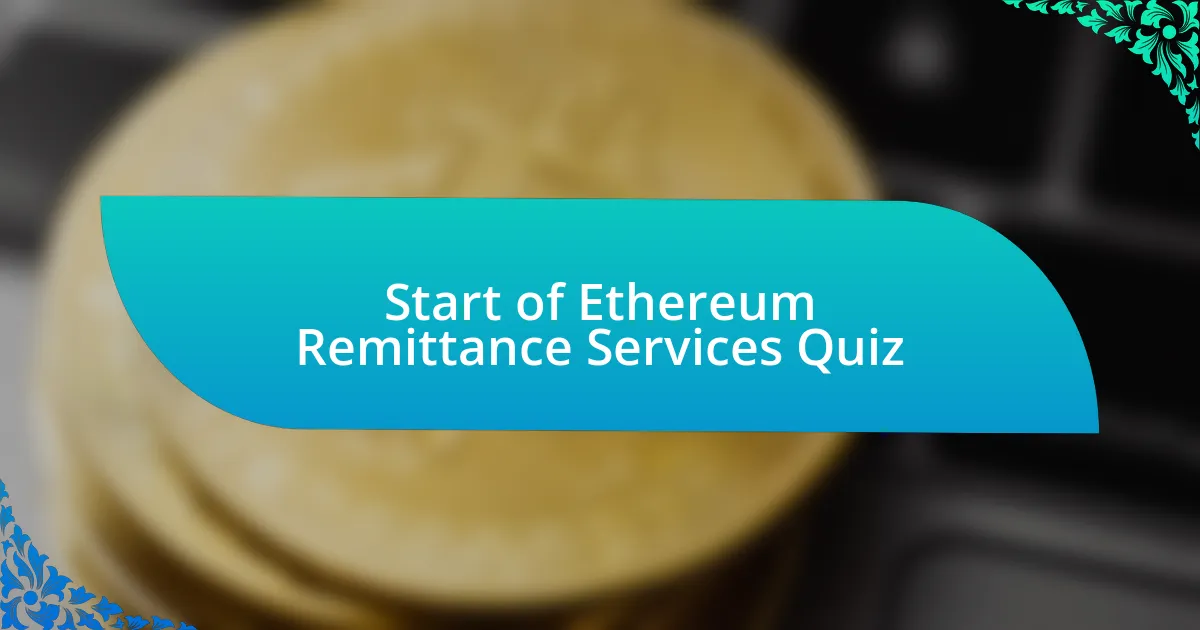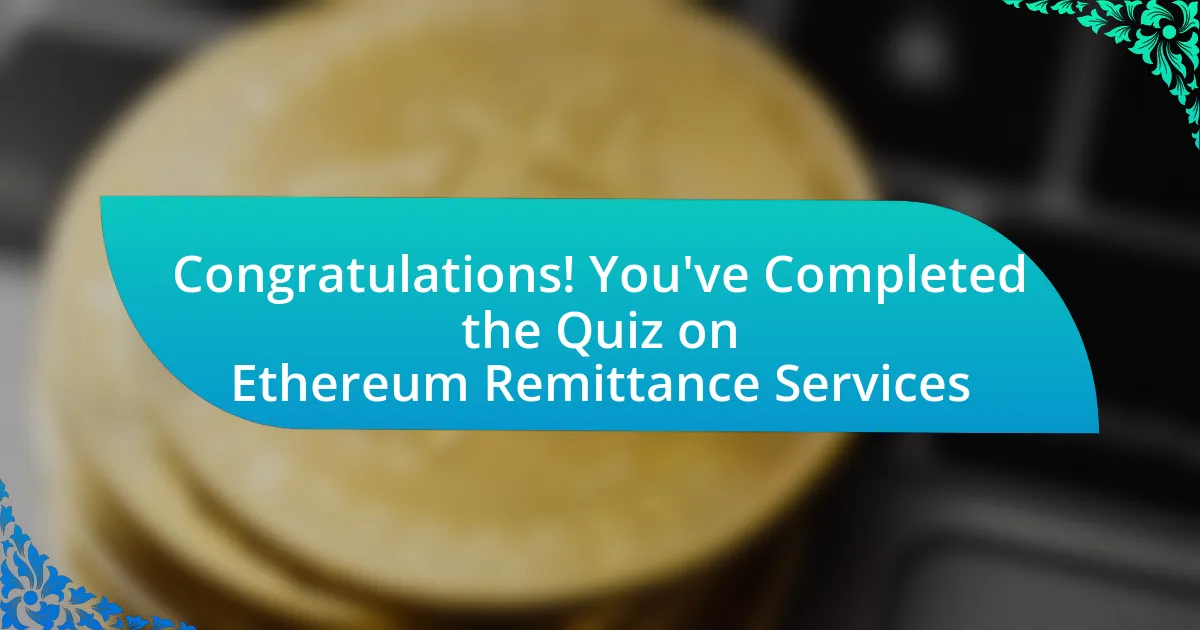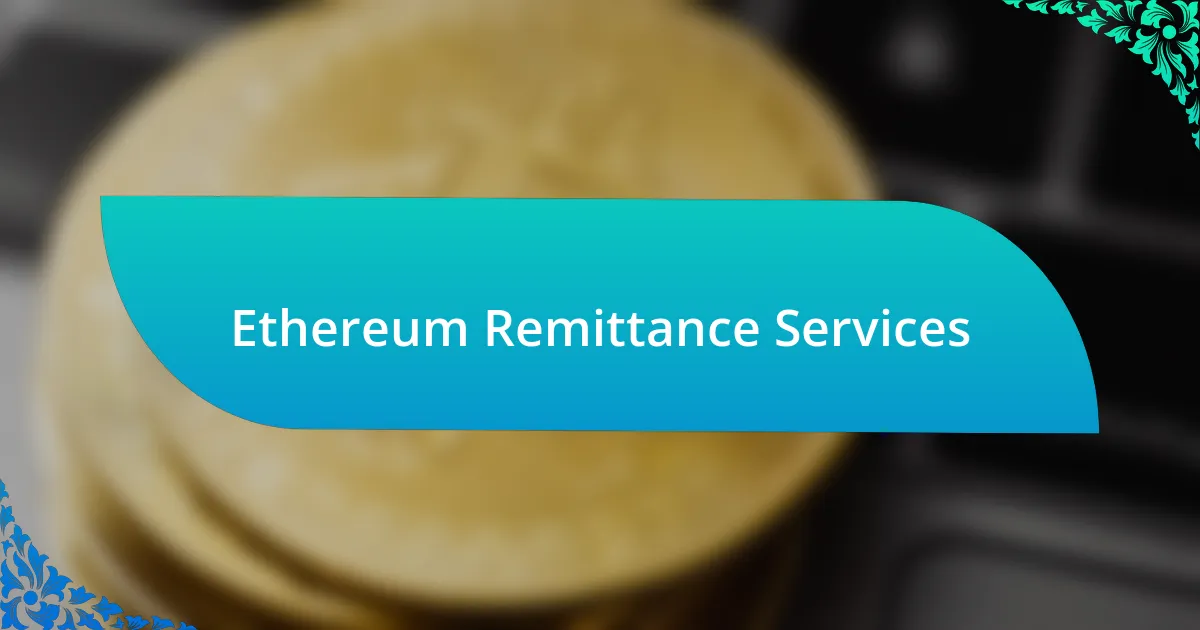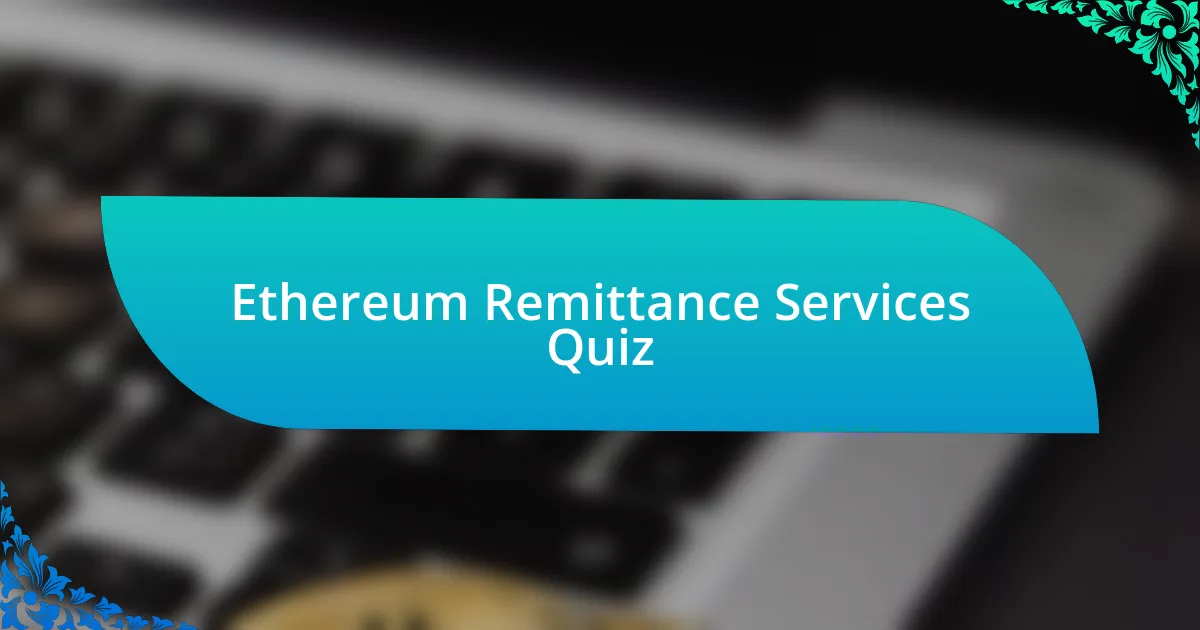
Start of Ethereum Remittance Services Quiz
1. What is Ethereum?
- Ethereum is a decentralized blockchain with smart contract functionality.
- Ethereum is a physical currency used for everyday transactions.
- Ethereum is a social media platform for cryptocurrency traders.
- Ethereum is a brand of computers designed for mining.
2. What is the primary function of Ethereum in remittances?
- Ethereum functions mainly as a digital wallet for storing various cryptocurrencies.
- Ethereum primarily serves as a social media platform for sharing financial advice.
- Ethereum acts as a traditional bank enabling loan services with high-interest rates.
- Ethereum facilitates cross-border transactions through its blockchain technology, reducing costs and increasing transparency.
3. Who are the original authors of Ethereum?
- Satoshi Nakamoto and Hal Finney.
- Vitalik Buterin and Gavin Wood.
- Elon Musk and Jeff Bezos.
- Charles Hoskinson and Joseph Lubin.
4. What is the Ethereum Virtual Machine (EVM)?
- The Ethereum Virtual Machine is exclusively a wallet for storing Ether securely.
- The Ethereum Virtual Machine is a centralized database for cryptocurrency transactions.
- The Ethereum Virtual Machine is a decentralized virtual machine capable of handling scripts using the public nodes network.
- The Ethereum Virtual Machine is a physical machine used for mining Ethereum.
5. What is the value token for Ethereum?
- Dogecoin (DOGE)
- Bitcoin (BTC)
- Ether (ETH)
- Litecoin (LTC)
6. What is Ether used for in the Ethereum network?
- Ether acts as a social media platform on the Ethereum network.
- Ether is used to create new cryptocurrencies on the Ethereum network.
- Ether serves as a replacement for traditional banking on the Ethereum network.
- Ether powers the Ethereum network, facilitating smart contracts and rewarding validators.
7. What is the consensus algorithm used by Ethereum?
- Proof-of-stake
- Practical Byzantine fault tolerance
- Proof-of-work
- Delegated proof-of-stake
8. How does Ethereum ensure the integrity and confidentiality of transactions?
- Ethereum relies on centralized servers to maintain transaction secrecy.
- Ethereum employs peer-to-peer messaging exclusively for transaction integrity.
- Ethereum uses advanced cryptographic techniques to ensure the integrity and confidentiality of transactions.
- Ethereum stores transaction data off the blockchain to protect user privacy.
9. What is the average transaction fee for sending Bitcoin and Ethereum?
- The average transaction fee for sending Bitcoin is $5.00, and for Ethereum, it is $2.00.
- The average transaction fee for sending Bitcoin is $1.50, and for Ethereum, it is $0.75.
- The average transaction fee for sending Bitcoin is $0.25, and for Ethereum, it is $1.00.
- The average transaction fee for sending Bitcoin is $3.00, and for Ethereum, it is $0.50.
10. Which platform processed $3.3 billion in remittances from the US to Mexico?
- Western Union
- Venmo
- PayPal
- Bitso
11. What is the typical fee range for BitPesa’s remittance services?
- 15% to 20%
- 5% to 7%
- 10% to 12%
- 1% to 3%
12. According to the UN, what is the highest cost percentage for sending remittances to some African countries?
- 20%
- 25%
- 15%
- 10%
13. What is required to send remittances using crypto?
- A bank account and a credit card are required to send remittances using crypto.
- A reliable courier service and postal tracking are required to send remittances using crypto.
- A physical cash deposit and a local agent are required to send remittances using crypto.
- A computing device with internet access and a crypto wallet are required to send remittances using crypto.
14. How does crypto ensure fairness and transparency in transactions?
- Crypto achieves fairness by ensuring all transactions are processed by a single founder with strict rules.
- Crypto ensures fairness and transparency in transactions through its decentralized operating system, which is not controlled by any central authority.
- Crypto enhances transparency by encrypting all transaction data, making it inaccessible to the public.
- Crypto guarantees fairness and transparency by utilizing blockchain mining techniques that slow down transactions.
15. What is the primary advantage of using crypto for remittances?
- It allows unlimited donation amounts only.
- It requires no internet connection.
- It reduces the time and cost associated with sending money abroad.
- It guarantees large profits for investors.
16. Which organizations launched a pilot blockchain payment solution in Ukraine in December 2022?
- The UN Refugee Agency and the Stellar Development Foundation
- The Red Cross and Litecoin
- The European Union and Bitcoin
- The World Bank and Ripple
17. What is the purpose of MoneyGram’s non-custodial digital wallet?
- To offer investment opportunities in cryptocurrencies.
- To create a centralized payment processing platform.
- To serve as a digital bank account for storing funds.
- To provide another option for remittances, subject to KYC requirements.
18. What is the typical wait time for traditional remittance services?
- One week
- Instant
- A few hours
- Several days
19. How does Ethereum’s blockchain technology ensure the immutability of transactions?
- Ethereum’s blockchain technology guarantees immutability through periodic backups of the ledger.
- Ethereum’s blockchain technology ensures immutability by storing transactions in a private database that can be changed.
- Ethereum’s blockchain technology ensures the immutability of transactions by recording them on a public ledger that cannot be altered.
- Ethereum’s blockchain technology secures transactions by using confidential data storage that prevents public access.
20. What is the role of smart contracts in Ethereum remittances?
- Smart contracts in Ethereum remittances facilitate the exchange of assets between parties, ensuring transparency and trust.
- Smart contracts in Ethereum remittances alter the transaction fees for every party involved.
- Smart contracts in Ethereum remittances require physical documents for every transaction.
- Smart contracts in Ethereum remittances automatically verify identity for all users.
21. How does Ethereum’s EVM handle transactions?
- Ethereum’s EVM handles transactions by validating them through the proof-of-work consensus algorithm and charging a fee to validators.
- Ethereum’s EVM processes transactions by creating new networks for each user.
- Ethereum’s EVM handles transactions by storing them in a separate off-chain database.
- Ethereum’s EVM secures transactions by relying solely on centralized servers.
22. What is the difference between the base fee and the tip in Ethereum transactions?
- The base fee is `burned` and the tip goes to the block proposer.
- The base fee and tip are both paid to the Ethereum Foundation.
- The base fee is optional while the tip is mandatory.
- The base fee is paid to miners and the tip is refunded.
23. How does Ethereum ensure the security of transactions?
- Ethereum guarantees security by using traditional banking systems.
- Ethereum relies on a single centralized server to secure transactions.
- Ethereum offers security against fraud by restricting access to its network.
- Ethereum ensures the security of transactions through advanced cryptographic techniques and the decentralized nature of its network.
24. What is the typical block time and average block size in Ethereum?
- The typical block time is approximately 14 seconds, and the average block size is around 2 KB.
- The typical block time is 10 seconds, with an average block size of 1 MB.
- The typical block time is 5 seconds, while the average block size is around 4 KB.
- The typical block time is 20 seconds, and the average block size is 8 KB.
25. Can transactions on the Ethereum network be kept hidden?
- No, transactions can be made confidential by default.
- Yes, they are fully encrypted and private.
- Yes, they use a hidden ledger for transactions.
- No, all transactions on the Ethereum network are public.
26. What is the purpose of the nonce field in a transaction?
- The nonce field in a transaction is used to identify transaction participants.
- The nonce field in a transaction is used to protect against replay attacks.
- The nonce field in a transaction is used to set transaction fees.
- The nonce field in a transaction is used for transaction prioritization.
27. How does Ethereum handle gas in transactions?
- Gas in Ethereum transactions is purely a measure of the size of the transaction data.
- Gas in Ethereum transactions refers to a fixed fee set by the network for all transactions.
- Gas in Ethereum transactions measures the computational effort required for actions, and modifying smart contracts incurs costs.
- Gas in Ethereum transactions is based solely on the number of users participating.
28. What is Remix used for in Ethereum development?
- Remix is used to create cryptocurrencies from scratch.
- Remix is used to deploy, test, and develop smart contracts.
- Remix is used to convert Ethereum into Bitcoin.
- Remix is used to mine Ethereum coins.
29. How does Bitcoin differ from Ethereum in checking the latest state?
- Bitcoin checks block headers, while Ethereum verifies transaction history instead of state.
- Bitcoin uses account balances for checking legitimacy, while Ethereum uses UTXO.
- Bitcoin and Ethereum both rely on a centralized server for state updates.
- Bitcoin checks unspent transaction outputs (UTXO), while Ethereum checks the latest state for the account balance.
30. What happens if gas runs out without the transaction being complete?
- The transaction is processed later when gas is available.
- The gas is refunded to the user for later use.
- The transaction completes successfully without issues.
- The transaction is reversed and gas is lost.

Congratulations! You’ve Completed the Quiz on Ethereum Remittance Services
Thank you for participating in our quiz on Ethereum remittance services! We hope you found it engaging and informative. By answering the questions, you have explored key concepts about how Ethereum facilitates international money transfers. You may have learned about the benefits of using Ethereum over traditional remittance methods, including lower fees and faster transaction times.
Quizzes can be a delightful way to gauge your knowledge and reinforce what you’ve learned. This quiz likely broadened your understanding of blockchain technology and its real-world applications in remittances. You’ll now appreciate the advantages Ethereum offers in making cross-border transactions more accessible and efficient for everyone, especially in developing regions.
To deepen your understanding, we invite you to check the next section on this page. Here, you’ll find an array of resources about Ethereum remittance services. This information will help you further explore this exciting topic and its implications for the future of finance. Stay curious and keep learning!

Ethereum Remittance Services
Introduction to Ethereum Remittance Services
Ethereum remittance services utilize the Ethereum blockchain to transfer funds across borders. These services aim to reduce costs and enhance the speed of transactions compared to traditional banking methods. By leveraging smart contracts, Ethereum allows for automated transactions that increase transparency and security. The use of Ether, Ethereum’s native cryptocurrency, facilitates these international transfers more efficiently than conventional currencies.
Advantages of Using Ethereum for Remittances
Ethereum offers several advantages for remittance purposes. The low transaction fees significantly decrease the costs incurred by users. Transactions often process within minutes, unlike traditional remittances that can take days. Additionally, Ethereum empowers users with full control over their funds, eliminating reliance on financial institutions. Enhanced security measures inherent in blockchain technology further protect user data and funds.
Key Players in Ethereum Remittance Services
Several companies provide Ethereum remittance services, facilitating the exchange of Ether for local currencies. These players include established crypto exchange platforms, decentralized applications (dApps), and fintech startups. These platforms create user-friendly interfaces to engage individuals unfamiliar with cryptocurrencies. They also provide customer support to assist users with the remittance process efficiently.
Challenges Facing Ethereum Remittance Services
Despite its advantages, Ethereum remittance services face challenges. Regulatory uncertainty in various jurisdictions can hinder service adoption. Additionally, transaction speeds may fluctuate due to network congestion, affecting the reliability of transfers. Users may also encounter issues with price volatility, as the value of Ether can change rapidly. These challenges necessitate ongoing improvement and adaptation within the industry.
Future Trends in Ethereum Remittance Services
The future of Ethereum remittance services appears promising, with potential growth driven by technological advancements and increased adoption. Emerging solutions like layer-2 scaling solutions aim to enhance transaction speeds and reduce costs further. As regulations become clearer, more users may trust and adopt these services. Cross-platform integrations also suggest a growing trend in interoperability among different blockchain networks, expanding the scope of remittance possibilities.
What are Ethereum remittance services?
Ethereum remittance services are platforms that enable users to send and receive money across borders using Ethereum, a blockchain-based cryptocurrency. These services leverage the Ethereum network’s smart contract capabilities to facilitate transactions with lower fees and faster processing times compared to traditional remittance methods. For example, remittance service providers like SendFriend and BitPesa utilize Ethereum’s technology to offer efficient money transfers, reducing costs often associated with banks or money transfer operators.
How do Ethereum remittance services work?
Ethereum remittance services work by allowing users to convert fiat currency into Ethereum, which is sent through the Ethereum blockchain to the recipient. Once received, the recipient can convert Ethereum back into their local currency. This process utilizes smart contracts to automate and secure transactions, ensuring a trustless environment. With Ethereum’s blockchain, each transaction is recorded, providing transparency and traceability. Services such as Transak and Wirex exemplify this method by allowing direct fiat-to-Ethereum conversions.
Where can I access Ethereum remittance services?
You can access Ethereum remittance services through various online platforms and mobile applications that specialize in cryptocurrency transactions. Many exchanges, such as Coinbase and Kraken, offer remittance capabilities by allowing users to send Ethereum as a form of payment to others. Additionally, dedicated remittance services like BitPesa serve specific regions, predominantly in Africa, making it easier for users in those areas to use Ethereum for transfers.
When were Ethereum remittance services first introduced?
Ethereum remittance services began to gain traction shortly after the launch of the Ethereum network in July 2015. As Ethereum gained popularity, various companies started to explore its potential for cross-border payments. By 2017, several dedicated remittance platforms, such as SendFriend and BitPesa, had emerged, spotlighting Ethereum’s role in revolutionizing traditional money transfer systems.
Who uses Ethereum remittance services?
Ethereum remittance services are used by individuals and businesses looking for cost-effective and efficient ways to transfer money internationally. Migrant workers seeking to send remittances to their families, freelancers receiving payments from clients across countries, and small businesses engaging in global transactions are typical users. A study by the World Bank indicates that remittances constitute a significant part of the economy for many developing nations, showcasing the demand for such services.

